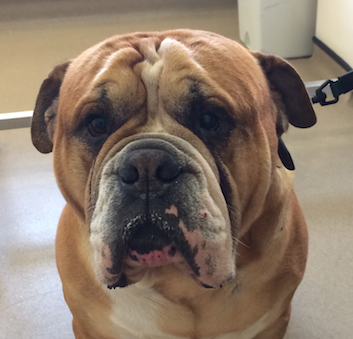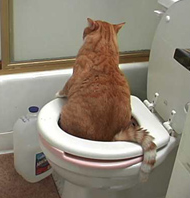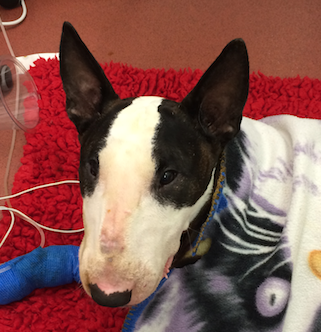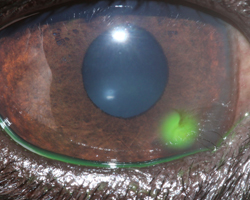Archive for February, 2014
by on February 27th, 2014
Category: Special Offers, Tags:

by on February 27th, 2014
Category: Pet of the Month, Tags:

Henry’s serious face belies a lovely and happy nature. He is seen here in one of his calmer moments after bounding into the clinic to greet us, prior to his monthly immunotherapy injection.
Immunotherapy, often referred to as desensitisation, is the closest thing to a cure for canine allergic dematitis. Immunotherapy is a well-established treatment and involves the administration of gradually increasing doses of allergen extracts over a period of weeks, given to patients by injection. After the initial induction course injections are administered monthly.
Although not effective in all cases, many patients like Henry benefit significantly from this therapy and we are delighted that his itching and skin lesions are much better on this treament.
by on February 27th, 2014
Category: News, Tags:

A ‘blocked’ cat describes a patient that can’t pass urine due to an obstruction. It is one of the true emergencies affecting cats and it can quickly become life-threatening (1-2 days). Any cat can be affected but it is much more common in males. It is therefore essential that everyone who lives with a male cat is aware of this condition.
What is a ‘blocked’ cat?
Like humans, cats have two kidneys which make urine by filtering the blood. Urine flows down (via tubes called ureters) from the kidneys into the urinary bladder; it is then excreted from the body through a tube called the urethra which connects the bladder to the outside. ‘Blocked cats’ are ones in which the urethra becomes obstructed preventing urine from being passed. Therefore the correct medical term for this blockage is a urethral obstruction.
Why is urethral obstruction more common in male cats?
In male cats the urethra runs from the bladder through the penis to the outside world. At a certain point there is a bend in the urethra and it becomes narrower; this is the main reason why male cats are much more commonly affected by urethral obstruction. In female cats the urethra is shorter, does not have a bend in it and does not become narrower.
Which male cats are more likely to be affected?
Urethral obstruction can be seen in all kinds of male cats but it is most common in ones that are:
- Overweight
- Confined indoors
- Fed dry food only
Many blocked cats are young or middle-aged and have been neutered – but the problem can occur in older cats and uncastrated ones as well.
What is it that blocks the urethra?
The urethra most often gets blocked by ‘plugs’ of material including protein, cells and little crystals and/or by stones (uroliths) formed from minerals. These substances are usually present in the urine in small amounts but they can build up and then cause an obstruction. This may be more likely in cats that do not consume enough water (either in their diet or by drinking) or that do not urinate often enough. Most blocked tomcats do not have a urinary tract infection.
Other much less common causes of urethral obstruction include tumours and in some cases a cause is not found.
Why is it a problem if the urethra becomes obstructed?
The body needs to be able to pass urine in order to get rid of substances (e.g. potassium, acid) that are harmful when they accumulate in the body. When the urethra gets blocked these substances are not removed, they build up in the cat’s body, and then have dangerous consequences making the cat extremely ill. The bladder often becomes hard and very painful for the cat as well.
How can I tell that my cat’s urethra may be obstructed?
It is important to realise that not all cats with urethral obstruction show the same signs. Some may just show non-specific signs such as being off their food or a little quieter than normal. Vomiting may occur, and at the opposite end of the spectrum some cats become very depressed and collapsed. There are some classical signs associated with urethral obstruction but remember that not all cats show these signs:
- Straining to urinate, maybe crying out when doing so
- Making frequent visits to the litter tray but only passing a few drops each time (‘spotting urine’)
- Discoloured urine due to blood
If your cat strains in the litter tray you should try and pay attention to whether they have passed faeces recently or not. Carers sometimes ring worried that their cat is constipated and then it turns out that in fact their bladder is blocked and the straining was because the cat is unable to pass urine.
Other signs that cats with urethral obstruction may show include:
- Walking abnormally at their back end – carers often mistakenly think the cat has had an accident of some sort
- Yowling as if in pain when picked up
It is essential to seek veterinary attention if you notice any of these signs in your cat, especially if the cat is male
by on February 3rd, 2014
Category: Special Offers, Tags:

by on February 3rd, 2014
Category: Pet of the Month, Tags:
 Poor Pilot. A typical Bull Terrier Pilot unfortunately doesn’t seem to have yet made the link between eating indigestible objects and the consequences in terms of vomiting and ultimately surgery. Seen here recovering from his second operation to remove an intestinal foreign body. This time it was a a foam ball that was invisible on radiography and ultrasonography but with all the signs pointing to an obstruction exploratory surgery was carried out. We are pleased to say that he has recovered well. Fingers crossed there is no next time!
Poor Pilot. A typical Bull Terrier Pilot unfortunately doesn’t seem to have yet made the link between eating indigestible objects and the consequences in terms of vomiting and ultimately surgery. Seen here recovering from his second operation to remove an intestinal foreign body. This time it was a a foam ball that was invisible on radiography and ultrasonography but with all the signs pointing to an obstruction exploratory surgery was carried out. We are pleased to say that he has recovered well. Fingers crossed there is no next time!
by on February 3rd, 2014
Category: News, Tags:

The cornea, the outermost layer of the eye, is a very special tissue that is completely transparent. In contrast to the skin, it lacks pigment and even blood vessels to maintain its transparency. The cornea is very rich with nerves, making it a very sensitive tissue. This is the reason why even small particles such as dust on the surface of the eye can be so uncomfortable.
The cornea is made of three layers:
- a very thin outer layer (epithelium)
- the thick middle layer (stroma)
- a very thin inner layer (endothelium)
All three layers are important for the cornea to work. The outer layer or ‘epithelium’ can be thought of as a layer of cling film that forms the surface of the cornea and protects it from infections. It works as a shield to the eye. The thick middle layer or ‘stroma’ is what gives the cornea its strength and stability.
Corneal ulcers are classified by the depth, depending on the layers they affect. If only the epithelium is missing this is classified as a ‘superficial ulcer’ (or surface defect only). If the ulcer reaches into the stroma it is classified as a ‘deep ulcer’.
While superficial or surface ulcers are uncomfortable and present a risk of infection to the eye; the eye is not at the risk of bursting unless additional problems occur. However when the ulcer gets deep the eye becomes weak and can even perforate. Deep ulcers lead to visible indentations on the surface of the eye and can be accompanied by inflammation inside the eye.
Signs of corneal ulcers usually include eye pain (squinting, tearing, depressed behaviour) and ocular discharge, which can be watery or purulent.
Sometimes a lesion may already be visible on the surface of the eye. In this case it is particularly important to seek help from your veterinary surgeon as soon as possible.
How is a corneal ulcer diagnosed?
To diagnose a corneal ulcer your vet may use a special dye that highlights any defects of the surface layer by staining the underlying tissue green (See Photo). This test is called the fluorescein test.
Why do corneal ulcers occur?
When the presence of an ulcer has been confirmed, it is important to try and find a reason for it. Most ulcers occur due to an initial trauma. This is more likely to happen in dogs and cats with very prominent eyes (also called ‘brachycephalic’ animals), for example in Pugs and Pekingese dogs or Persian cats. In cats the flare up of a Feline Herpes Virus infection is also a common cause for the development of a corneal ulcer. Many conditions can increase the risk of corneal ulcers. Reduced tear production is a common contributing factor, but other conditions such as an incomplete blink, in-rolling of the eyelid (also called ‘entropion’) or eye lid tumours may contribute to the occurrence, but even more so may interfere with the healing process.
How are corneal ulcers treated?
To treat an ulcer it is essential that the underlying cause is identified and if possible corrected. This will stop the ulcer from getting worse and allow the eye to heal as quickly as possible. The treatment plan will usually include eye drops to treat or prevent infection but may include other medication depending on the cause and severity of the ulcer. Painkillers and/or antibitotics by mouth may also be necessary.
Do any corneal ulcers require an operation?
If an ulcer is deep or the cornea is even ruptured, surgery is required to save the eye. Different techniques are available, but all of them place healthy tissue into the defect to stabilise the cornea. Very small suture material, as thin as a human hair, is used to repair the cornea and an operating microscope should be used to handle the small and very fine structures of the eye. Grafting surgeries are very successful in saving eyes, but can lead to scaring of the cornea leaving it less transparent in areas.
How can corneal ulcers be prevented?
Corneal ulcers are best prevented and if they are present they should be treated as soon as possible to stop them from getting bigger and deeper.
Particularly in patients with prominent eyes, regular eye examinations should be performed to detect weaknesses in the corneal health. Indications of that may include white or brown marks on the surface of an otherwise comfortable eye or sticky discharge that continues to recur. Any painful eye should be presented to a veterinary surgeon as soon as possible.
Eyes may be cleaned with tap water that ideally should be boiled and cooled down again, using a lint-free towel. This should however not replace or delay the visit to a veterinary surgeon, as many ulcers require medication to achieve fast healing and prevent ill effects to the transparency of the cornea and therefore the sight of the dog or cat. Particularly; if a deep indentation or bulging tissue is noted on the surface, the eye should not be manipulated to prevent any additional damage.
 Poor Pilot. A typical Bull Terrier Pilot unfortunately doesn’t seem to have yet made the link between eating indigestible objects and the consequences in terms of vomiting and ultimately surgery. Seen here recovering from his second operation to remove an intestinal foreign body. This time it was a a foam ball that was invisible on radiography and ultrasonography but with all the signs pointing to an obstruction exploratory surgery was carried out. We are pleased to say that he has recovered well. Fingers crossed there is no next time!
Poor Pilot. A typical Bull Terrier Pilot unfortunately doesn’t seem to have yet made the link between eating indigestible objects and the consequences in terms of vomiting and ultimately surgery. Seen here recovering from his second operation to remove an intestinal foreign body. This time it was a a foam ball that was invisible on radiography and ultrasonography but with all the signs pointing to an obstruction exploratory surgery was carried out. We are pleased to say that he has recovered well. Fingers crossed there is no next time!




